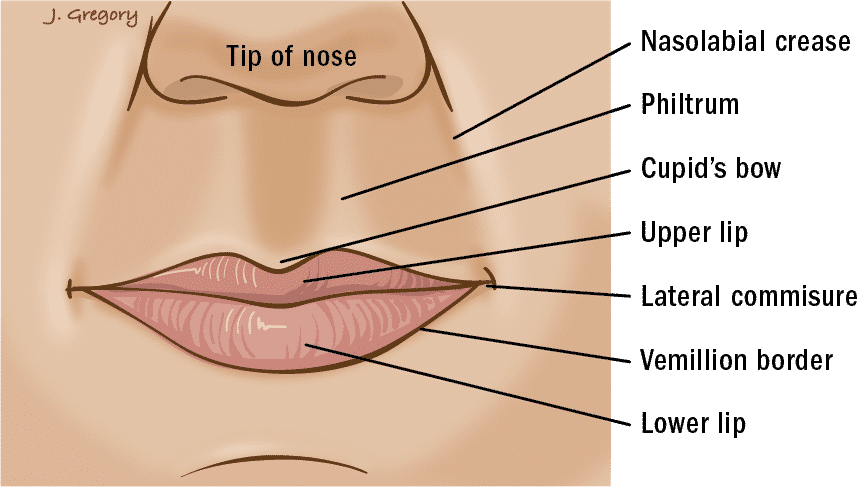What & Where is the Lip Region?
The upper and lower lips serve as the gateway to the rest of the oral cavity. They are responsible for protecting the mouth and for holding food and drinks inside the mouth as a person chews and swallows. They also play a role in articulation, which is how a person forms clear sounds when they speak.
Lip Anatomy
The upper and lower lips consist of several regions, including the mucosal lips, which consist of the pink skin from the vermillion border to where the lips meet when closed. The corner where these mucosal lips join up is the lateral commissure.
Cancers on the lip fall into two categories: skin cancers, originating from normal skin, or oral cavity cancers, emerging from the pink part of the lips. Commissure cancers, however, are rare.

Causes, Signs & Symptoms
A patient, dentist or doctor lip cancers can typically see or feel the presence of lip cancer—unlike other cancers of the head and neck. This is the most common way for a cancer on the lip to be identified. If a patient has a lesion that doesn’t go away after a few weeks—or maybe even after trying some medicines—they should get an evaluation for lip cancer.
Common Causes of Lip Cancer
- Ultraviolet radiation
- Tobacco
- Alcohol
- Betel nut
Common Symptoms
- A lump or lesion on the lip
- Recurrent bleeding from the lip
- Numbness (e.g. in the lower teeth or lower lip/chin area)
Diagnosis
The diagnosis phase can be difficult and overwhelming. During this phase, further testing will be necessary to confirm a diagnosis and determine the best course of treatment. Patients can expect their doctor to have a discussion with them about the risks, benefits, and alternatives to having a physical examination, a biopsy and having imaging scans performed.
Type, Grade & Stage
After diagnosing a patient with lip cancer, a doctor will need to determine what type of cancer it is, the grade of the tumor (i.e. the risk level), and the stage of the cancer based on a biopsy or pathology after surgery.
It is important to note that oral cancers can be difficult to diagnose. If a doctor is having a hard time determining what type of cancer it is, they might ask for a second opinion and send some pieces of the tumor off to a specialist in head and neck pathology who deals more frequently with these types of tumors.
Treatment Plan
After determining a diagnosis and completing a full pre-treatment evaluation, doctors will recommend a course of treatment for their patients.
In general, there are three different options for the treatment of lip cancers that can be used alone or in combination: surgery, radiation and chemotherapy.
Prognosis
A prognosis is a prediction of the outcome of one’s disease. How likely is survival? Will the cancer come back? These are the big questions on most people’s minds after receiving a diagnosis of lip cancer.
In general, there are 5 tumor characteristics that can inform a patient about their chances of being cured: the stage, the site, the type & grade, the spread to lymph nodes, the tumor margins and the spread into local structures.
What to Expect After Treatment
After treatment, patients should follow-up with their doctors on a regular basis.
Patients should visit their head and neck specialist on a regular schedule (or earlier if they have any concerning symptoms). This allows doctors to monitor the patient for any sign that the cancer has returned. The best timeline for follow-up will be determined by the doctor.












